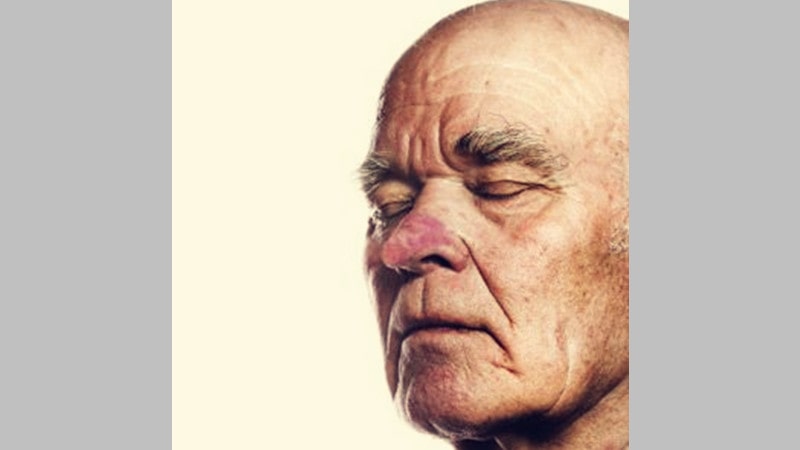You might be familiar with the stereotype of alcoholics having a plump nose and a red face. In fact, that portrayal is extremely common in Hollywood movies or cartoons, where drunk characters feature an almost unnaturally large nose.
Nevertheless, the idea of red-faced characters that you may find in a cartoon tavern has also crossed into real life in a way. Unfortunately, people who suffer from the so-called alcoholic nose may experience some stigma that prevents them from seeking medical help.
That’s why, today, let’s go through the ins and outs of alcoholic nose and find out more about this unique condition.
What Is an Alcoholic Nose?

Image source: Pinterest
The condition that’s colloquially known as alcoholic nose is characterized by a bumpy, large nose that has either a red or purple color. However, while most people refer to it as an alcoholic nose, the disorder is actually called rhinophyma. Even so, you’ll find that it has many other names, such as:
• Drinker’s nose
• Bulbous nose
• Whiskey nose
• Gin blossom nose
• Old man’s nose
• Gin nose
• Pickle nose
• Cauliflower nose
Does Alcohol Abuse Cause Alcoholic Nose/Rhinophyma?

Although rhinophyma has many nicknames related to alcohol, the reality is that alcohol abuse doesn’t cause this condition. Actually, rhinophyma stems from rosacea, a chronic skin disease that causes swollen or red skin and sometimes bumps. It’s important to mention that when rosacea starts to spread from the nose, it is called rhinophyma, which means swelling of the nose.
While alcohol doesn’t directly cause rhinophyma, it is often associated with facial redness or flushing. Therefore, you shouldn’t assume that someone with this condition suffers from alcohol addiction. However, excessive drinking can and will worsen rhinophyma and rosacea, which leads many people to believe that there is a link between them.
Sadly, the cause of rhinophyma is not clear, with doctors still struggling to find an explanation. Yet, most of them agree that risk factors include fair complexion, genetics, and European heritage. Not only that but alcoholic nose is more common amongst middle-aged men in comparison to women of any age.
What Are the Symptoms of Alcoholic Nose?
As previously mentioned, the main symptom of rhinophyma is a red or purple swollen nose. Yet, there are other signs that you or someone close to you may be dealing with alcoholic nose:
• Dry skin
• Red cheeks
• Flushed skin
• Red patches on the skin
• Large pimples, pustules, or bumps on the nose
• Rough facial or nose skin
• Broken blood vessels on the nose
• Red tip of the nose
• Dilated pores on the cheeks or nose
• Red face
• Purple-like hue on the skin
Is There Any Treatment?

Image source: Pinterest
Generally speaking, an alcoholic nose can be treated using medication and surgery depending on its severity. Mild rhinophyma can respond pretty well to medication such as antibiotics and topical anti-inflammatories. In contrast, surgery is the only way to treat severe cases of a drinker’s nose. Let’s check each of them out.
1. Medication
Even though there is no medication that can reverse the effects of rhinophyma, some symptoms can be managed using it. For instance, nose redness caused by rosacea can be reduced using prescription medication with a high rate of success.
Most doctors will prescribe one of the following types of medication for those suffering from mild rhinophyma:
• Topical medications that minimize inflammation, such as azelaic acid and tretinoin
• Topical and oral medications to reduce redness, like sulfacetamide, tetracycline, erythromycin, and metronidazole
• Oral capsules in order to block your skin glands from producing oil
2. Surgery
Sometimes, the only way to deal with rhinophyma is through surgery. Why? Because the enlarged blood vessels that cause this condition can become permanently enlarged and spread to nearby areas as well.
The following surgical methods have been proven successful against advanced rhinophyma:
• Laser resurfacing using a carbon dioxide laser
• Classic scalper surgery
• Dermabrasion, which is the removal of the top layers of skin
• Cryosurgery
It’s essential to understand that, when left untreated, rhinophyma can affect your nostrils, which can lead to breathing problems. If you experience any symptoms, you should check with a doctor as soon as possible.
Can I Prevent an Alcoholic Nose?
Prevention is better than cure, regardless of what disorder or condition you are suffering from. However, since the main cause of rhinophyma is still under debate, it’s hard to prevent it entirely. Fortunately, in addition to medication, you can prevent an alcoholic nose by making some changes to your diet. You should avoid foods and drinks that can trigger rosacea, like alcohol.
Other triggers that you should avoid include:
• Sun exposure
• Hot beverages
• Spicy food
• Stress
• Certain exercise
• Temperature shifts
Featured image source: Pinterest.com







